A drive around the Loire, 2005

All the pictures <- Loire Valley <- France <- Home

|
I decided to take a Friday and a Monday off from work, to give myself a four day holiday, and after much thought we decided to go to the Loire valley and do the chateau thing. We booked tickets to Blois, which is on the East end of the area of highest castle density, and then rented a car for the full four days. In addition, when Sasha was looking around for info on the web, she ran across a castle which did a special all-inclusive package on Fridays, and we decided to contact them and see if there was still availability. There was, and while it was more than we usually spend, we decided to go for it, figuring you don't often have the chance to spend the night in a castle, and since it included dinner and breakfast the price wasn't totally unreasonable. To make up for all the money we were going to spend on the car and hotel, we took a tent and sleeping bags along, hoping to spend the rest of the weekend in somewhat cheaper accomodation. We arrived in Blois around 11 A.M. on Friday, and rather than hoofing it to the car rental place, which was quite distant from the train station (1), we decided to take a taxi. He drove us straight there, and after an amusing conversation with the young woman who rented us the car, we got underway. Partly because I didn't want to drive through town, we headed East toward Chambord, one of the more famous castles in the Valley. As it turned out, they were having a big hunting expo on the grounds of the castle, so as we toured the castle the sound of gunfire was heavy in the air. Chambord was built by Francois the 1st in 1519. You can tell he built it because there are little carved 'F's and Salamanders (his symbol) everywhere. It has a double helix staircase which was reputedly designed by Leonardo Da Vinci. It's important to note that for the entire trip, the temperature stayed in the high 80s and low 90s (low to mid-30s for the non-Farenheit people). It was toasty. So we spent as much time as possible inside the castles, where the temperature was much, much cooler. We were drinking water as fast as we could find it, and on more than one occasion I paid awe-inspiring amounts for a small can or bottle of water. We headed from Chambord southwest, to Fougeres sur Bievre. We drove into town, and there was the castle (and not much else!) The woman who sold tickets was away, but a sign on the door asked us to wait in the garden until she came back. Which we did. We were completely alone in the castle for pretty much our entire visit to the castle, which made it absolutely wonderful, especially after Chambord, and its busloads and busloads of visitors. Fougeres was interesting because rather than filling it with period furniture, they chose to make it a museum of medieval building techniques. As the castle itself was built in 1450, a museum of this type fit right in. Unlike Chambord, which was a hunting lodge for the king, this castle was more of a 'workaday' castle - it belonged to a noble family of no great importance. We departed from Fougeres with the intention of going to Chenonceau, but were waylaid by a sign pointing to an Abbey. So we stopped off in Pontlevoy. The abbey was closed, but we came in through a back driveway and wandered around parts of it. And then we were off.(2) Onward to Chenonceau, which we nearly skipped. It was another seven euro castle (my measure of expensive castles started at seven. Less than seven was a cheap castle), and it was late. But I really wanted to see the castle that went over the river. So in we went. Chenonceau has a varied history. It was owned originally by Diane de Poitiers, who was the king's (Henri II's) lover. When Henri died, his wife, Catherine de Medici forced Diane to trade castles, giving her Chaumont in exchange (bizarrely, she bought the castle for the exchange). There are two gardens on the castle grounds, one done by Catherine, the other by Diane. The most interesting feature, however, is the extension which crosses the river. Diane de Poitiers had a bridge built from the castle, crossing the river (Le Cher), and then Catherine de Medici had it covered, and added another floor. Much later, the castle played a role in both world wars. In WWI, it was a military hospital, and in in WWII, the river served as the boundary between occupied France and Vichy France. Thus the bridge through the castle became one method of escaping occupied France. From there, we started the long drive to our hotel. We hadn't realized that the place we were staying, which was a castle built in 1810, was quite so far from where we had ended up. We thus arrived with just enough time to clean up for dinner, served in a glass addition to the castle. The grounds had been converted to a golf course, and after dinner we took a walk around them, past the frog ponds that doubled as water hazards. We managed to avoid the sprinklers, and wandered back to our room, which was in one of the large towers. (3) The next morning, we had a pretty solid plan in mind, so we set off headed more or less south, with the intention of visiting several castles in the general vicinity, and ending up in or around Chinon, a place known both for its castles and its wines. The first stop on our trip was Champchevrier, a chateau dating mostly from the 18th century, with some bits dating back another few centuries. The rather high entry fee got us into the grounds and some of the servants quarters. After we had wandered around for a bit (and seen the doggies being trained for the hunt by guys on bikes!) we were halfway ready to go, but the bell rang for the guided tour, and we figured we'd already paid for it. The guide was finding out from the other couple (from Holland) that English would be the preferred language of the day, and as she hadn't given the tour in English before, it was bound to be interesting. She took us into the house proper, and went on a ramble through the house, which was filled primarily with random stuff picked up over time. The guide was a student worker, and took every opportunity to learn words for things, which the Dutch guy happily told her (sometimes correctly). The next castle was Cinq-Mars, which happened to be on our way and was old enough to interest Sasha (12th century). It was closed when we arrived, and the bell intended to summon someone didn't seem to work, so we almost left before the old man arrived and opened the door. Upon entering, we discovered he had been mowing the lawn (which had grown up over the past weeks, as his lawn mower had been broken, he informed us). The castle itself was a ruin, partially populated by paintings and stained glass done by the caretaker aand his family. In the 19th century a romantic had owned the castle, and had planted a 'wild garden' around the ruins. The area around the castle was quite overgrown, and fun to wander through. We departed Cinq-Mars, and managed to get back on the main road without getting hit (the parking area was on a steep hill), and wandered further southward to the Chateau de Langeais, which was a lovely little castle in a cute little village designed specifically, I think, to cater to visitors to the castle. The castle itself dates from the 15th century, and was the site of the wedding of Charles VIII and Anne of Bretagne, about whom we learned quite a lot, thanks to several displays, and a light, sound, and mannequin show (really!). There was also a modern wedding party doing their photos out on the grounds of the castle. The grounds had the remnants of a 10th century tower. We had a light lunch in front of the castle at a small cafe, and then headed to Chinon. There was a nice campground located just across the river from the city, with a great view of the castle. We got a spot ('anywhere is fine') and set up the tent. We then headed into the city, originally not to visit the castle, but then we did. It was hot. No, hotter than that. It was scalding. Blindingly hot. Hot. So we wandered the castle grounds in a sweaty stupor. The castle was mainly from the 12th century, with some apartments from the 15th century. One of the had been converted to a Joan of Arc museum, with lots of really silly memorabilia. According to the legend locals want to believe, it was in Chinon that Joan of Arc met Charles VII, whom she would eventually restore to the throne. We left the castle, and went on a mad hunt for water and toilet paper (which the camp ground did not provide) but eventually gave up and went to a restaurant instead, paying far more for dinner than we had for the campground, but managing to get lots and lots and lots of water, and steal some TP in the process. The tent was hot. I learned one does not put the rain fly on when one wants to stay cool in a tent. The next morning, it was still hot. We headed to a nearby coffee shop and then to a bakery, and thus fortified packed up and headed to the abbey of Fontevraud. This abbey was traditionally patronized by the counts of Anjou, so when Henry II of England married Eleanor of Aquitaine, and thus became the count of Anjou, he and his wife continued to patronize the abbey. Henry and Eleanor, along with their very famous son, Richard the Lion Heart (and their less famous daughter, Joan of England) are all buried in the abbey, and have very nice tombs. Another interesting part of the abbey was the romanesque kitchen from the 12th century, which was basically a cone topped by dozens of chimneys. For us, the multitude of (swifts?) that were nesting in the cloisters were also terribly fun. We headed from Fontevraud to Saumur, which was closed to people, so we admired it from a distance, and then headed on to the Chateau de Breze, which was interesting for two, very distinct reasons. One, it had a winery. We tasted several, and bought six of a sparkling white. Second, the tour attraction of this castle was not the castle itself, but rather the tunnels, passages, and living areas which had been tunneled out of the rock surrounding the castle, which has the deepest dry moat in France. The living areas were both under the castle and in the rock which formed the far side of the moat. From what we saw driving, burrowing into the rock is quite common in this area, and this castle showed that they had been doing it for quite a while. We headed from Fontevraud all the way across the southern side of the Loire valley, ending up in Loche. Loche was a very small city with a very big map (as the guy at the tourist office proved by giving us one - it was almost hard to use, as you would constantly overshoot where you wanted to go). We didn't have time to see the entire complex, but we managed to visit the 14th century apartments which had been built by Charles VI, and later resided in by Agnes Sorel, mistress of Charles VII (who also had a place in Chinon, with a secret entrance to the castle). It was also here, or so we were told, that Joan of Arc came to implore Charles VII to be crowned in Reims. The flamboyant gothic chapel was added in 1500 by Anne de Bretagne, whom you might remember from Langeais. We also visited the collegiale saint-ours, a church from the 12th century with a strange, pyramid-shaped roof. We were camped down in the new city, near the river, and having learned our lesson in Chinon, we were much cooler the second night. The proximity of the river forced me to hide in the car when I phoned my dad for Father's day, as the mosquitoes were plentiful. The next morning, we headed north, meandering towards our final destination of Blois, where we would return the car. Our first mission was to find coffee, so when we stopped in Montresor (4), we headed straight to a cafe. The waiter appeared to be either (a) very friendly with the locals, or (b) desperate for company, was talking the heads off of two other patrons of the cafe, telling the story of some Australians who couldn't read the menu. Needless to say, he couldn't help them. We finished and headed to the castle, which had been owned by a Polish nobleman in the 19th century, and has apparently been left exactly as it was when he passed away, complete with scary dead things on the walls, and lots and lots of Polish mementos. The castle itself was built in 1483 by the grandfather of Diane de Poitiers (whom we met at Chenonceau). After the castle, we wandered into the village, and to the cute little church. We left Montresor, and headed north to Montpoupon, which was in the middle of nowhere, and was thoroughly shut for lunch. Montpoupon was obviously a functioning farm, and had lots of ads around showing its equestrian links. But we couldn't get in, so we wandered around a bit, and then headed on to Montrichard, where we discovered a small cafe with the worst service in France, possibly the world. After wasting far too much time there, we headed up to the castle, where the nice ticket woman asked us, in a somewhat bewildered tone, how we had found the castle. After wandering around a bit, we wondered that ourselves. The castle had been converted into a sort of catch-all local museum. Our last castle before heading back to Blois was Chaumont, which was named for 'chaud mont', or 'hot mountain'. Thus there were little mountains with flames on them carved in all the walls. The castle was mostly built in the 15th century. In the 18th century, someone decided that the view would be better if they knocked down the North wing. So they did, which makes the castle seem a bit odd (and a bit unsafe). This castle was purchased in 1560 by Catherine de Medici, right after her husband died, and promptly 'given' to Diane de Poitiers in exchange for Chenonceau (Diane was not given a choice about the exchange - and do you want to make Catherine de Medici angry?) An interestng display in the castle showed a prominent cameo-maker's work, including several done of Ben Franklin. We left Chaumont and headed to Blois, which I managed to drive through without killing anyone (although a detour en route to the rental agency nearly did me in). We had the rental agency call us a taxi, and boarded our train back to Paris. (3) - The hotel is called Le Château des Sept Tours, and can be found on the web at www.7tours.com. (4) - Montresor, according to the tourist map, is 'one of France's most beautiful villages'. |
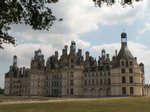  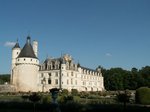   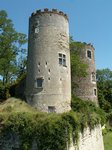      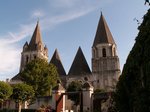 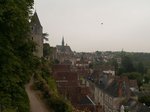  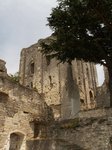 
               
    |